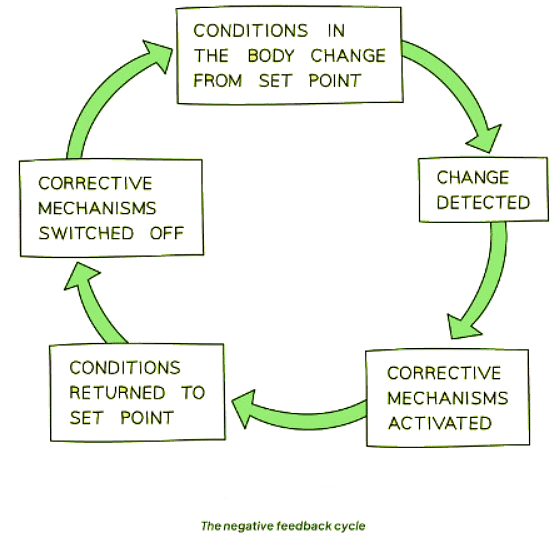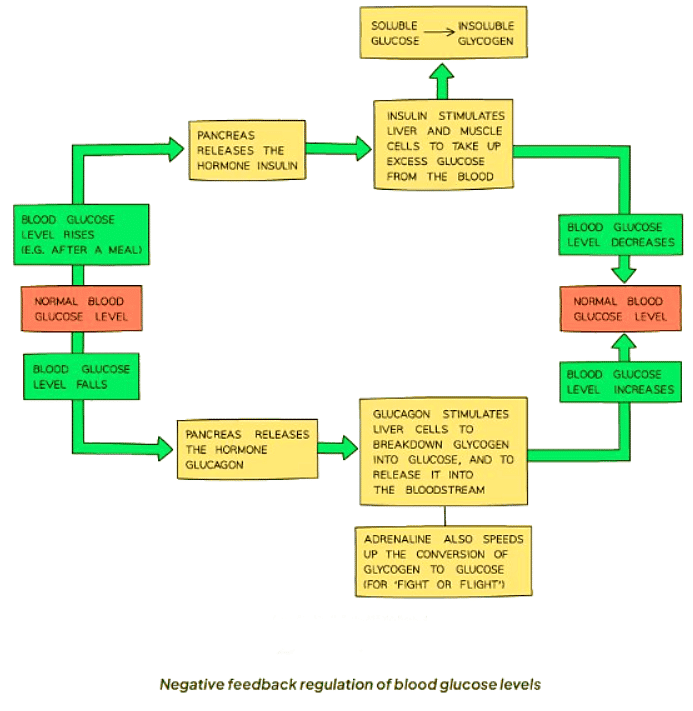Year 11 Exam > Year 11 Notes > Biology for GCSE/IGCSE > Homeostasis
Homeostasis | Biology for GCSE/IGCSE - Year 11 PDF Download
The Concept of Negative Feedback
- Negative Feedback Mechanism Explanation: Negative feedback occurs when conditions deviate from the ideal or set point and mechanisms act to return conditions to this set point. It operates by triggering control systems to either decrease or increase levels to maintain stability.
- Operational Process: When the level of a substance rises, control systems are activated to decrease it; conversely, when the level falls, systems are engaged to elevate it back to the set point.
- Continuous Regulation: Negative feedback mechanisms operate in a cyclical manner, continuously adjusting levels to keep them within a narrow range considered normal. This ensures stability and homeostasis in biological systems.

Blood Glucose Control
- Blood glucose levels are regulated by a feedback system that involves two crucial hormones: insulin and glucagon.
- Both insulin and glucagon, vital for controlling blood sugar levels, are manufactured in the pancreas.
- Insulin is secreted in response to elevated blood glucose levels. It triggers liver and muscle cells to convert excess glucose into glycogen for storage.
- Glucagon, on the other hand, is released when blood glucose levels drop. It prompts the liver and muscle cells to convert stored glycogen back into glucose, which is then released into the bloodstream.

Type 1 Diabetes
- Type 1 diabetes is a health condition characterized by the body's inability to regulate blood glucose levels due to the pancreas not producing sufficient insulin.
- This results in consistently elevated blood glucose levels, which can lead to various health complications.
- Treatment for Type 1 diabetes typically involves regular insulin injections to help manage blood sugar levels effectively.
- Injected insulin prompts the liver to convert glucose into glycogen, thereby reducing the concentration of glucose in the bloodstream.
- Common symptoms of Type 1 diabetes include excessive thirst, weakness, blurred vision, weight loss, and in severe cases, loss of consciousness.
- Individuals with Type 1 diabetes need to monitor their blood glucose levels regularly, adjusting their insulin doses based on factors like physical activity and diet.
- Managing blood glucose levels involves maintaining a balanced diet that avoids rapid spikes in blood sugar and engaging in physical exercise to promote glucose regulation.
Question for HomeostasisTry yourself: What is the purpose of negative feedback mechanisms in biological systems?View Solution
The document Homeostasis | Biology for GCSE/IGCSE - Year 11 is a part of the Year 11 Course Biology for GCSE/IGCSE.
All you need of Year 11 at this link: Year 11
|
110 videos|158 docs|34 tests
|
FAQs on Homeostasis - Biology for GCSE/IGCSE - Year 11
| 1. How does negative feedback help maintain homeostasis in the body? |  |
Ans. Negative feedback mechanisms work to counteract changes in the body and maintain a stable internal environment. For example, if blood glucose levels rise, the body releases insulin to lower them back to the normal range. Conversely, if blood glucose levels drop, the body releases glucagon to raise them back to the normal range.
| 2. How is blood glucose regulated through negative feedback? |  |
Ans. Blood glucose levels are tightly regulated through a negative feedback mechanism involving the hormones insulin and glucagon. Insulin is released by the pancreas in response to high blood glucose levels, promoting the uptake of glucose by cells for energy or storage. Glucagon is released by the pancreas in response to low blood glucose levels, stimulating the release of stored glucose into the bloodstream.
| 3. What is the role of insulin in blood glucose control? |  |
Ans. Insulin is a hormone produced by the pancreas that helps regulate blood glucose levels. It promotes the uptake of glucose by cells, where it can be used for energy or stored for later use. Insulin also inhibits the breakdown of glycogen in the liver, which helps to lower blood glucose levels.
| 4. How does Type 1 Diabetes affect blood glucose regulation? |  |
Ans. Type 1 Diabetes is a condition where the pancreas does not produce enough insulin, leading to high blood glucose levels. Without enough insulin to regulate glucose uptake by cells, individuals with Type 1 Diabetes must rely on insulin injections to manage their blood glucose levels.
| 5. What are the risk factors for developing Type 2 Diabetes? |  |
Ans. Risk factors for Type 2 Diabetes include obesity, physical inactivity, poor diet, genetics, and age. Individuals with Type 2 Diabetes may still produce insulin, but their cells become resistant to its effects, leading to elevated blood glucose levels. Lifestyle changes, such as maintaining a healthy weight and regular exercise, can help prevent or manage Type 2 Diabetes.
Related Searches





















